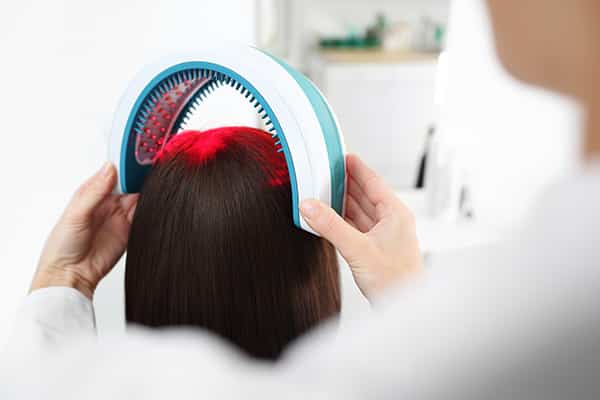- Otorhinolaryngology (ENT)
- Hair Transplant
Hair Transplant
Hair loss can be devastating but it doesn’t have to be permanent! Restore your confidence today with hair transplantation
Hair Transplant
Hair loss can be devastating but it doesn’t have to be permanent! Restore your confidence today with hair transplantation
Hair Transplants in Houston, TX
What Causes Hair Loss?
Hair loss can be a devastating process. Understanding the cycle of hair growth can be helpful in understanding hair loss and options for slowing progression of hair loss and hair restoration.
While loss of scalp hairs can be devastating, scalp hairs account for a small number (100,000-150,000) of total hairs (5 million) on the body. Hair growth is classified into three stages: anagen, catagen and telogen. During anagen, active growth occurs. This phase can last about 3 years and 90% of hairs exist in this phase. During catagen, the hair will separate from the dermal root over 2-3 weeks leading to telogen which is the hair’s resting phase. During telogen, the hair shaft falls out. This phase lasts for 3-4 months and 10% of hairs exist in this phase. Thinning occurs when the rate of hair loss exceeds the rate of growth.
Male pattern baldness is driven by the conversion of testosterone to a compound called dihydrotestosterone (DHT). DHT triggers the transformation of thick and healthy hair into thin and fine baby hair (called vellus hairs). It is these fine and thin hairs that predominate in areas that are balding. The rate of conversion of thick healthy hair into vellus hair is dependent on genetics.

Treatment Options
Rogaine (Minoxidil)
Minoxidil was first administered in the 1970s as an oral blood pressure medication and was observed to have the side effect of hypertrichosis (hair growth). These early observations led to the development of a topical formulation of minoxidil to treat hair loss. Several theories exist regarding how Minoxidil works. Minoxidil has been shown to cause increased bloody supply to the areas treated, increase the proportion of hair follicles in anagen phase and increase the overall follicle size. Studies have shown that 5% topical application is effective in increasing hair growth. Two formulations are available: foam and liquid, the foam formulation has no propylene glycol and may be better tolerated (less irritating to the scalp). There is an increased risk of shedding in the first 3-4 weeks of use but this indicates the medication is working.

Propecia (Finasteride)
Finasteride is a medication commonly given for benign prostatic hypertrophy at a dose of 5 mg/day (Proscar). It is also a highly effective medication given for hair loss at a lower dose of 1 mg/day and is marketed as Propecia/finasteride for this purpose. The mechanism of action is inhibition of the enzyme 5-alpha-reductase. This enzyme converts testosterone to dihydrotestosterone (DHT) which is the active molecule that binds androgen receptors in the hair follicle to induce patterned baldness. A randomized controlled trial of 1553 men given placebo or finasteride showed significantly greater hair counts in the balding vertex after one year than in patients receiving placebo. While sexual side effects have been reported, these side effects are rare and are usually reversible upon discontinuation of the medication. Finasteride can be taken any time of the day without food, please allow 6-9 months to see results.
PRP
PRP is a medical treatment for hair loss. During PRP treatment, your blood is drawn, processed to separate the platelet rich plasma which is then injected into the scalp. There have been numerous studies showing that PRP is effective in stimulating hair regrowth. It is thought that the rich growth factors and signaling molecules to promote active hair growth.
Laser
Low level laser light therapy is an FDA approved treatment for hair loss. The mechanism is not well understood but clinical studies have demonstrated that low level laser light delivered to the scalp will stimulate hair growth, reverse miniaturization of hairs (vellus hairs) and improve overall density to the scalp. There are many laser options available. Schedule an appointment to learn more about this treatment modality.
Hair Transplant
Hair transplant is an effective way to restore a natural and youthful hairline. In hair transplant, individual follicular units are harvested from areas in the scalp that are resistant to the action of DHT. Follicular units are hairs that naturally grow in 1 to 4 haired groups. Even patients with advanced balding will retain a strip of resistant hairs in the temporal and occipital regions. These hairs are resistant to miniaturization and retain this property when transplanted. These hairs serve as the donor hairs for transplant. One or more sessions may be required to achieve the desired result. Typically, one to two sessions is sufficient depending on degree of hair loss and the number of grafts needed.
Follicular Unit Transplant
Also known as FUT, follicular unit transplant is an excellent technique to acquire high quality hair grafts for transplant. In FUT, a strip of hair is harvested from the occipital scalp. The hair is then expertly slivered into individual units and then transplanted in specially designed recipient sites.
Follicular Unit Extraction
Also known as FUE, follicular unit extraction is gaining popularity. In this technique, a motorized punch is used to remove individual follicular units from the scalp. This technique requires expertise as individual hairs can easily be transected or damaged during harvesting and overall graft survival is lower. The individually extracted follicular units are then transplanted in specially designed recipient sites.

Hair transplantation is both a technical and artistic procedure. Excellent technical skill is absolutely paramount in a successful transplant but the artistry required in successful transplant is often overlooked. When you choose your transplant surgeon, you are also choosing your artist. Careful design of the hairline is needed to give a natural look. Each follicular unit serve as individual strokes of a paintbrush. Balance and foresight into future hair loss must be artfully combined to give the best result. Call for a consultation today!
Assistant Professor
Houston, TX 77030-1532
(713) 486-5019



